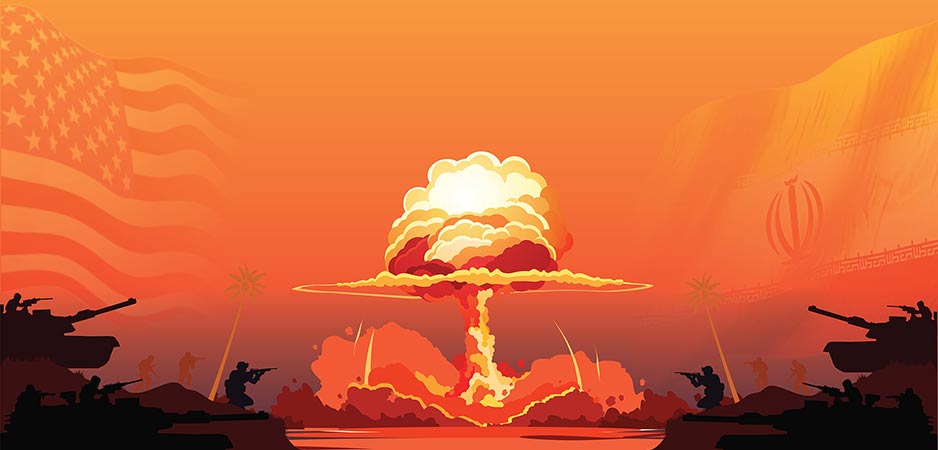
The assassination of the commander of Iran’s Quds Force, Major General Qassem Soleimani, by the United States on January 3, along with his right-hand man in Iraq, Abu Mahdi al-Muhandis, was a surprising move for many. Soleimani’s assassination increased pressure on President Donald Trump in Washington and has already intensified concerns about a new war between the US and Iran, which would be a disaster for the region.
On January 8, Iran carried out a ballistic missile attack on air bases hosting US forces in Iraq in retaliation for Soleimani’s death. So far there are no reports of American casualties, but Iran claims it killed at least 84 US soldiers. This has not been independently confirmed.
Iran’s retaliation seems more symbolic. Tehran wanted to respond to its domestic impulse for revenge. According to Adel Abdul Mahdi, the Iraqi prime minister, Iran informed him about the attack. According to Iraqi diplomatic sources, the attack has been “coordinated” with Washington in advance in order to avoid fatalities.
Was Qassem Soleimani a Bad Guy or a Martyr?
READ MORE
If this is true, Iran’s retaliation happened just to save face, on the one hand, and avoided a full-blown war with the US, on the other. Iran’s foreign minister, Javad Zarif, quickly tweeted after the attack on the US bases in Iraq that Iran took “concluded proportionate measures” and, similarly, Donald Trump tweeted that “so far, so good.” It sounds like a process of de-escalation now.
Proxy War
In Soleimani, Iran lost a well-known strategist. Soleimani was the mastermind of Iran’s asymmetric warfare in the region, comparable perhaps to someone like General Akhtar Abdur Rahman, director-general of Pakistan‘s Inter-Services Intelligence (ISI) between 1979 and 1987. Rahman was the architect of the jihad movement against the Soviets in Afghanistan in the 1980s when Pakistan supported, organized and trained the Afghan mujahedeen.
This strategy is known as “death by a thousand cuts.” As head of Quds Force — the external branch of the Iran Revolutionary Guard Corps (IRGC) — for more than 20 years, Soleimani made it his mission to force the United States from the region.
Inside Iran, Soleimani was considered a “pillar of the Iranian Revolution itself” and has been portrayed as Iran’s most powerful man after Supreme Leader Ayatollah Ali Khamenei. Outside Iran, he became a charismatic leader for many of Tehran’s allies like Hezbollah in Lebanon, Kataib Hezbollah in Iraq and other Iran-backed militant groups in Syria and Yamen. He was also considered as a mastermind of Iran’s strategy in the fight against the Islamic State (IS) in Iraq and Syria. After the defeat of IS, Iran continued putting pressure on the US through proxies.
The Middle East has been squished into the spectrum of radical securitization and open hostility between aligned actors for a long time. Four decades of confrontation with the US and the Iran–Iraq War in the 1980s pushed Tehran to adopt an asymmetric strategy to fight threats beyond its borders. US presence in the region has been perceived as the primary threat by Tehran since 2002, when President George W. Bush included Iran as part of the “axis of evil.”
Iran’s concerns intensified after the US-led invasion of Iraq in 2003. Since then, one option for Iran was to increase the cost of the US presence in the region. Maintaining its regional influence and fighting real or perceived threats beyond its borders has been a key goal for Tehran, especially following the breakout of the civil war in Syria.
Potential for Escalation
Based on what has happened between the US and Iran in the few last days, we can draw some conclusions. First, proxy warfare has the potential to transform into a full-blown war. On December 27, a US contractor was killed and four other Americans wounded when more than 30 rockets were fired on the Iraqi military base near Kirkuk. Washington accused Kataib Hezbollah, an Iran-backed militia, for the attack. Two days later, the US launched airstrikes and killed at least 25 militia fighters, wounding 55.
The attack sparked violent protests by supporters of the Iran-backed militia groups, targeted at the US Embassy in Baghdad. The protests brought back unwelcome memories of the 2012 attack on the US Embassy in Benghazi, Libya, that took the lives of four Americans, including Ambassador John Christopher Stevens. The embassy attack also brought up the specter of Iran’s hostage crisis of 1979. All these events have pushed the US and Iran a step closer to a full escalation.
Second, responses to proxy warfare are not the same. For example, Soleimani’s assassination raises the question about US reluctance to take similar action against Pakistan’s generals who are supporting the proxy war in Afghanistan. On May 2, 2011, the Haqqani Network — a military branch of the Taliban based in Miramshah, Pakistan — launched an attack against the US Embassy in Kabul.
The US accused Pakistan’s ISI of supporting the attack. Admiral Mike Mullen, then chairman of the US Joint Chiefs of Staff, told the US Senate that “the Haqqani network, for one, acts as a veritable arm of Pakistan’s Inter-Services Intelligence agency,” and that “with ISI support, Haqqani operatives planned and conducted that truck bomb attack, as well as the assault on our embassy.”
Since 2001, more than 2,400 Americans troops have died in combat with the Pakistan-backed Taliban in Afghanistan. Pakistan has been denying its support for the Taliban and keeps insisting on its position as a “key ally” of the US in the war on terror. Pakistan’s strategy is a “double game” that enables it to have both a relationship with the US while pursuing its regional strategy by providing sanctuaries for the Taliban.
However, the US treats Pakistan differently because their relationship is based on a combination of diplomatic interaction and tactical engagement. Also, Pakistan pursues its regional strategy without insisting on political and ideological differences to fuel confrontation with Washington.
Washington justified the attack on Soleimani as “preemptive action” to avoid further attacks against the US in the region. In April last year, the US designated the IRGC as a terrorist organization. According to Reuters, IRGC provided more sophisticated weapons to the pro-Iran Shia militia in recent months. These weapons included Katyusha rockets and shoulder-fired missiles that could bring down helicopters. Despite these concerns, many were surprised by the unilateral decision to assassinate high-profile officials, with experts questioning US evidence suggesting an imminent attack on American targets as “razor thin.”
The Right Temperature
Third, countries have different proxy war strategies. In comparison, Pakistan conducts its proxy warfare differently to Iran. In the 1980s, in the context of the Cold War, General Mohammad Zia-ul-Haq, the Pakistani president at the time, instructed the ISI that “the water in Afghanistan must boil at the right temperature.” He was worried about a full Soviet escalation against Pakistan.
However, it is hard to know what is the right temperature for avoiding direct confrontation. Perhaps Iran raised the heat too high by its bold involvement in Iraq and Syria. Soleimani played a vital role in helping the Syrian government of Bashar al-Assad, mobilized tens of thousands of Shia militia from Iraq to Lebanon, and provided them with arms and military advisers. This level of involvement intensified the concerns in Washington about its future in the region. Leaked archives of Iranian intelligence cables show that Iranian agents privately expressed concern about Soleimani’s brutal tactics in Iraq and their consequences.
Fourth, the US does not have a good record of fighting proxy wars in the region, but this should not create a false sense of confidence. After 2001, the US fought insurgencies in Afghanistan and Iraq, which had required a different military doctrine known as counter-insurgency strategy (COIN). However, the COIN doctrine resulted in no substantial achievement in either theaters.
In Afghanistan, the US ultimately started negotiations with the Taliban to withdraw its forces. This happened after 18 years of war that cost an estimated $2 trillion and tens of thousands of Afghan lives. Pakistan appears to have won the proxy war in Afghanistan against the US to bring back the Taliban and undermine the Afghan government. The US failure in the region gave more confidence for Soleimani to play the game with confidence. For example, he kept promoting himself by taking photos on battlefields across Iraq and Syria, not unlike a rock star.
Fifth, Iran’s real revenge will come through the continued proxy warfare to force the US from the region. After Soleimani’s death, Iran will pursue cautious methods without changing its main strategy in the region. Iran has vowed to take “severe revenge” for Soleimani’s death, but its conventional forces are no match for the US military machine in a direct confrontation. Therefore, Iran will not fight a conventional war with the US.
After a ballistic missile attack on the US bases in Iraq, President Hassan Rouhani said: “Our final answer to his [Soleimani’s] assassination will be to kick all US forces out of the region.” Iran already pulled out of the nuclear deal, and Iraq’s parliament has passed legislation calling for the US forces to leave the country. If it happens, the US will likely end its presence in Syria as well because the US bases in Iraq are critical for the support of US forces in Syria.
After Soleimani’s death, the situation is extremely unpredictable. Proxy warfare can provoke an all-out war whether with the US or regional actors. From Tehran’s point of view, the US is not the only threat in the region, with enemies such as Saudi Arabia, Israel and anti-Iran Sunni groups such as IS and al-Qaeda to be considered.
Even if the US leaves the Middle East, the existing pattern of the amity/enmity between state and non-state actors in the region will remain stubborn for the foreseeable future. Therefore, it seems that Iran will not gamble its whole capability on a full escalation with the US. However, any miscalculation can push the US and Iran toward further escalation. If retaliation happens as tit for tat on a spiraling trajectory, a full-blown war could not be far away. This is how wars begin.
*[Updated at 20:40 EST on January 9, 2020]
The views expressed in this article are the author’s
own and do not necessarily reflect Fair Observer’s editorial policy.



